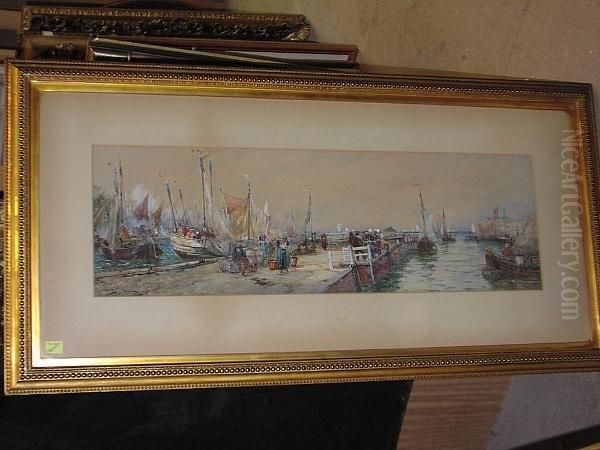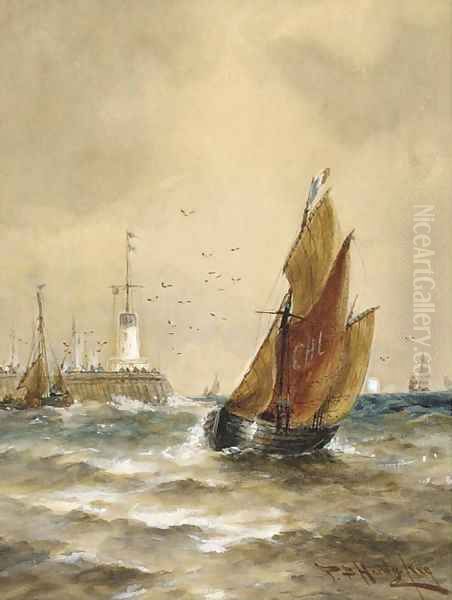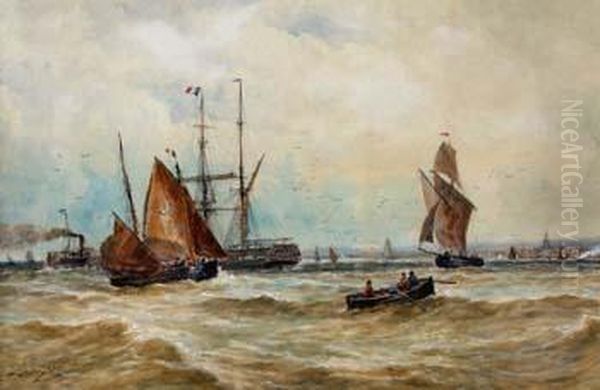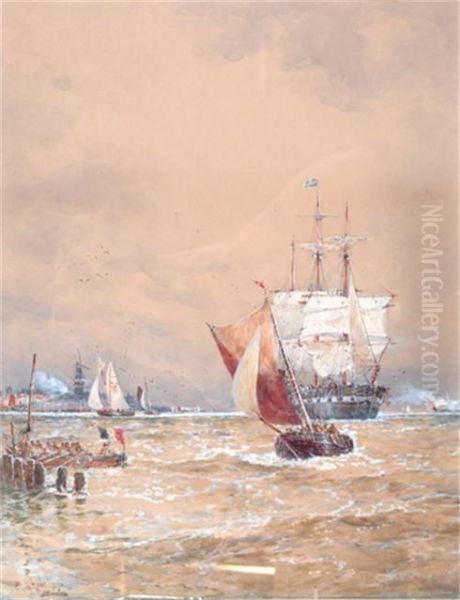Introduction: Capturing the Maritime Spirit
Thomas Bush Hardy stands as one of the most prolific and recognisable British marine painters of the later Victorian era. Active during a time when Britain's maritime power was paramount and the sea permeated national consciousness, Hardy dedicated his artistic career almost exclusively to capturing the diverse moods of the ocean and the bustling life along coastlines and in harbours. Working primarily in watercolour, a medium he mastered with apparent ease and remarkable speed, he produced an extensive body of work that appealed greatly to the public taste for dramatic, atmospheric, and meticulously observed seascapes. His paintings, often characterized by their energetic brushwork and keen sense of light and weather, continue to be appreciated for their evocative portrayal of the sea in all its forms, from tranquil harbours to storm-tossed shipping lanes.
Early Life and Artistic Beginnings
Thomas Bush Hardy was born in Sheffield, Yorkshire, on May 3, 1842. Details about his early education and initial artistic inclinations are scarce, leading many to believe he was largely self-taught as a painter. His early adulthood took an unexpected turn; at the age of 19, around 1861, he travelled to the United States. Reports suggest he enlisted and participated briefly in the American Civil War. However, this military interlude was short-lived. Ill health forced him to return to England approximately a year later, in 1862.
Back in England, Hardy did not immediately pursue art full-time. By 1870, he had settled in London and initially took up employment as a clerk. It was during this period in the capital, the heart of the British art world, that his passion for painting solidified. Gradually, he transitioned from his clerical duties to dedicating himself entirely to art, finding his true calling in the depiction of marine subjects. His lack of formal academic training seems not to have hindered him; instead, he developed his skills through direct observation and practice, quickly gaining proficiency in the watercolour medium.
Development of a Distinctive Marine Style

Hardy rapidly developed a distinctive and highly recognisable style. His primary medium was watercolour, often enhanced with bodycolour (gouache) to achieve highlights and textural effects, particularly in depicting breaking waves or bright sunlight on sails and water. He became known for his ability to work quickly and confidently, capturing the fleeting effects of light, weather, and movement that are so characteristic of marine environments. His style was less concerned with the highly detailed, almost photographic finish favoured by some Pre-Raphaelite influenced marine painters like John Brett, and more focused on conveying the overall atmosphere and energy of a scene.
His subject matter was drawn from the coasts and seas he knew well. The English Channel, with its busy shipping traffic between England and France, was a frequent source of inspiration. He painted numerous scenes off Calais, Dover, and other Channel ports. The Dutch and Belgian coasts, particularly the beaches and fishing communities like Scheveningen, also featured prominently in his work, allowing him to depict picturesque fishing vessels (known as 'pincks' or 'bomschuiten' in Dutch contexts) and lively shore activities. Venetian scenes, capturing the unique interplay of water, architecture, and light in the Italian city, added another dimension to his oeuvre, showcasing his versatility.
Influences and Artistic Context
While considered self-taught, Hardy did not work in a vacuum. He was undoubtedly aware of, and likely influenced by, the great tradition of British marine painting. The atmospheric drama in his work echoes the legacy of J.M.W. Turner, perhaps the most influential figure in British landscape and marine art. More direct influences likely came from successful Victorian marine specialists such as Clarkson Stanfield and Edward William Cooke, both renowned for their accurate depiction of ships and their ability to render convincing sea textures and weather effects. Stanfield, in particular, was celebrated for his large-scale, often dramatic, marine canvases.
Hardy operated within a thriving Victorian art market where marine painting was extremely popular. He was a contemporary of other notable marine artists. William Lionel Wyllie emerged as a major figure, known for his dynamic views of the Thames and naval subjects, often working in oil and etching as well as watercolour. Charles Napier Hemy specialised in powerful depictions of coastal life and fishing boats, often working from his floating studio. Henry Moore (the marine painter, not the later sculptor) was another respected contemporary known for his open-sea subjects and meticulous studies of wave forms. Hardy's particular niche was his fluid, rapid watercolour technique applied to a wide range of popular coastal and shipping scenes.
Themes and Subject Matter

Hardy's work consistently revolved around the sea and human interaction with it. Bustling harbours filled with fishing boats, ferries, and larger sailing ships were a favourite theme. He excelled at depicting the organised chaos of ports like Calais or Dover, capturing the movement of vessels, the figures on the quaysides, and the specific quality of light reflecting off the water and buildings. Coastal scenes, featuring fishing boats drawn up on beaches or navigating choppy near-shore waters, were equally common. Scheveningen beach in the Netherlands provided a recurring motif, often depicted under grey, windswept skies with characteristic flat-bottomed Dutch fishing boats.
He was adept at portraying different weather conditions. Sunny days with bright blue skies and sparkling water appear in his Venetian views and some Channel scenes. However, he seemed particularly drawn to more dramatic effects: brewing storms, blustery winds whipping up whitecaps, ships battling heavy seas, or the atmospheric haze of early morning or late evening. This ability to capture mood and weather contributed significantly to the appeal of his work. Unlike some marine painters who focused heavily on the technical accuracy of ship portraiture, Hardy's primary interest lay in the overall scene, the interplay of elements, and the feeling evoked by the sea and sky.
Watercolour Technique and Illustration
Hardy's mastery of watercolour was central to his success. He typically worked with broad, fluid washes to establish the sky and sea, often allowing colours to blend on the paper to create soft transitions or suggest atmospheric effects. He used drier brush techniques and finer lines to delineate the details of ships, figures, and coastal architecture. His frequent use of opaque white or bodycolour was characteristic, employed effectively to depict cresting waves, spray, highlights on wet surfaces, and the bright flashes of flags or sails in sunlight. This technique added vibrancy and a sense of immediacy to his work.
His speed and facility with watercolour also lent themselves well to illustration. During his career, Hardy undertook work for major illustrated periodicals of the day, including The Illustrated London News and The Graphic. These publications relied on artists who could quickly produce effective and informative images of current events or scenes of interest. His contributions likely involved marine subjects, further disseminating his style and name to a wide audience beyond the gallery-going public. This commercial work required clarity and narrative skill, qualities also evident in his exhibition watercolours.
Exhibitions, Recognition, and Associations

Thomas Bush Hardy was a prolific exhibitor, ensuring his work was regularly seen by the public and potential patrons. He exhibited frequently at the Royal Society of British Artists (RBA) on Suffolk Street, a major venue for artists outside the Royal Academy. His success here was significant, leading to his election as a member of the RBA in 1884. He also showed numerous works at the Royal Institute of Painters in Water Colours (RI), another important society promoting the medium. While he did exhibit occasionally at the prestigious Royal Academy (RA), his presence was more consistently felt at the RBA and RI.
Despite his proficiency and popularity as a watercolourist, Hardy repeatedly sought election to the elite Royal Watercolour Society (RWS, sometimes known as the 'Old' Watercolour Society) but was never admitted. The reasons for this remain unclear but may relate to perceptions of his style as perhaps too commercial or rapidly executed compared to the more highly finished works often favoured by the RWS membership at the time. Nevertheless, his work found a ready market among private collectors who appreciated its vigour and atmospheric charm. He was also associated with the Langham Sketching Club, a social and artistic hub known for its timed sketching challenges, which likely suited Hardy's quick working methods. His reputation was that of a robust and energetic painter, fully engaged with his maritime subjects.
Representative Works
Several works can be considered representative of Thomas Bush Hardy's style and typical subjects.
The Old Pier: This watercolour, specifically mentioned in the source material, likely depicts a harbour scene, possibly featuring a French vessel given the reference to flags. It would showcase his ability to handle architectural elements alongside shipping, capture the bustling atmosphere of a working port, and utilize his characteristic vibrant colour and fluid technique. Such scenes were a staple of his output.
Coastal Voyage: Also mentioned, this title suggests a scene of shipping navigating along a coastline. This could range from small fishing boats battling choppy seas near cliffs to larger vessels sailing under dramatic skies. It represents his core subject matter – the interaction of ships, sea, and coast.
Off Calais or Shipping off Calais: Hardy painted numerous views of the French port and the busy shipping lanes nearby. These works often feature cross-Channel ferries, fishing boats, and sometimes larger sailing ships, typically under changeable Channel weather conditions. They highlight his skill in depicting choppy water and atmospheric skies.

Scheveningen Beach: Views of this Dutch location are common in his work. They often show the wide, flat beach with characteristic Dutch fishing boats ('bomschuiten') drawn up on the sand or navigating the surf, usually under breezy, cloud-filled skies. These works capture a specific sense of place and maritime culture.
Venetian Lagoon Scene: Hardy also travelled to Venice and produced watercolours capturing its unique atmosphere. These works often focus on the interplay of light on water, the distinctive Venetian architecture, and the gondolas or sailing craft navigating the lagoons and canals. They demonstrate his ability to adapt his style to different light conditions and settings.
These examples illustrate the range of Hardy's typical subjects – harbours, coastal navigation, specific locations like Calais, Scheveningen, and Venice – and his consistent focus on atmospheric effects and maritime activity, rendered in his fluid watercolour style.
Place in Victorian Art and Contemporaries
Thomas Bush Hardy occupied a solid position within the broad landscape of Victorian art. While perhaps not reaching the critical acclaim or influence of innovators like Turner before him, or the detailed intensity of John Brett, he was a highly successful and popular artist in his chosen field. His work satisfied a public appetite for accessible, evocative, and often dramatic depictions of the sea, a subject deeply ingrained in British identity.
Comparing him to his contemporaries helps define his contribution. William Lionel Wyllie shared Hardy's interest in maritime subjects but often brought a more modern sensibility and a focus on naval power and the industrialised Thames. Charles Napier Hemy's work, frequently in oil, often had a greater sense of weight and physical struggle, particularly in his depictions of fishermen. Henry Moore (the marine painter) was perhaps more focused on the scientific observation of sea and sky. Hardy's strength lay in his prolific output, his consistent focus on watercolour, and his particular knack for capturing atmosphere with speed and confidence. His style was less analytical than Moore's, less gritty than Hemy's, and perhaps less varied in subject than Wyllie's, but it possessed a direct, energetic appeal.

His work can also be seen in the context of the wider Victorian watercolour tradition, which included artists focused on different subjects, such as the detailed rural landscapes of Myles Birket Foster or the atmospheric, often topographical, views of Albert Goodwin. Hardy represented the specialist marine painter within this tradition. Furthermore, his work continues a lineage traceable back through Stanfield and Cooke to earlier British marine painters like Samuel Owen and William Anderson, and ultimately connects to the foundational work of Dutch Golden Age marine artists like Willem van de Velde the Younger, who established many conventions of the genre.
Later Life and Legacy
Thomas Bush Hardy remained productive throughout his career, maintaining a consistent output of marine watercolours. He passed away relatively young, on December 15, 1897, at the age of 55, in Maida Vale, London. His death occurred at the height of his popularity.
His legacy rests on his vast body of work, which provides a vivid pictorial record of coastal and maritime life in the late Victorian era. He captured the transition from sail to steam, the daily life of fishing communities, and the enduring power and beauty of the sea. His watercolours are admired for their technical facility, their atmospheric truth, and their sheer energy. While perhaps not considered a major innovator, he was a master craftsman within his chosen genre and medium.
His son, Dudley Hardy (1867-1922), also became a well-known artist, but notably diverged from his father's path. Dudley achieved fame as a painter of figurative subjects, particularly scenes of French life, and was highly influential as a poster designer, embracing Art Nouveau aesthetics. This contrast highlights Thomas Bush Hardy's dedicated focus on traditional marine painting.
Today, Thomas Bush Hardy's watercolours remain popular with collectors and are frequently seen at auction. They are held in numerous public collections, particularly in the UK, valued for their artistic merit and as historical documents of Britain's maritime world. He stands as a key figure in the popularisation of marine watercolour painting in the late 19th century, an artist who skillfully captured the enduring allure of the sea for his Victorian audience. His ability to convey the drama, beauty, and activity of the maritime world ensures his continued recognition.